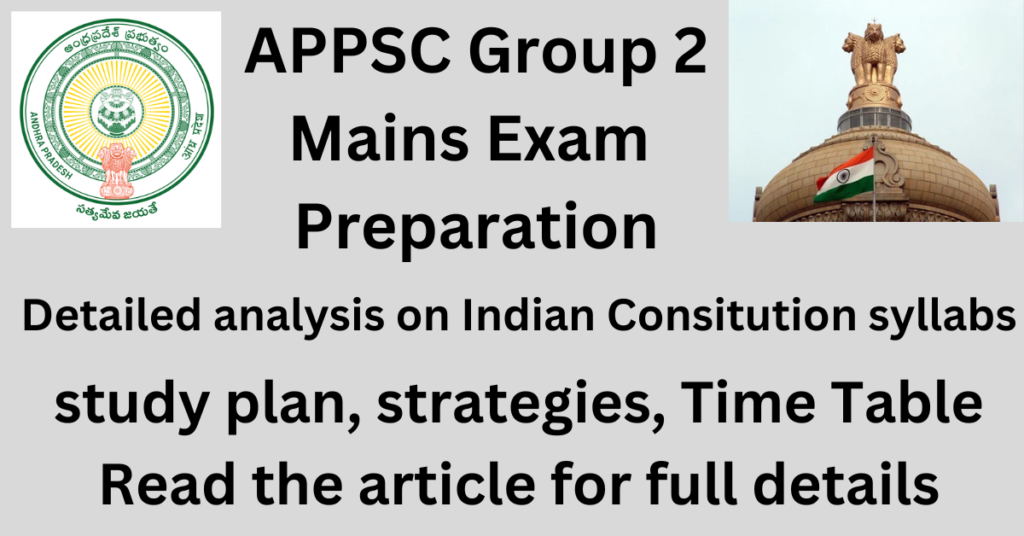The Indian Constitution is a critical topic for the APPSC Group 2 Mains Exam, forming the backbone of India’s political framework. Mastering this subject requires a structured and detailed approach, as it encompasses a broad spectrum of concepts ranging from historical evolution to the dynamics of governance and federalism. Below is a well-organized study plan, complete with a timetable, to help aspirants excel in this segment of the syllabus.
1. Introduction to the Indian Constitution for APPSC Group 2 Mains Exam
The Indian Constitution serves as the supreme law, outlining governance structures and principles. Start with understanding its nature, evolution, and key features.
Key Areas to Focus On:
- Nature of the Constitution: Federal in structure, unitary in emergency.
- Constitutional Development: Study the Government of India Acts (1919, 1935), and the Indian Independence Act (1947).
- Salient Features: Length, rigidity vs. flexibility, Fundamental Rights, and Directive Principles.
Study Approach:
- Historical Analysis: Review the evolution of constitutional ideas.
- Key Documents: Focus on the Constituent Assembly Debates and landmark acts.
- Memorization: Highlight important aspects like the Preamble and its objectives.
2. Preamble and Fundamental Rights
The Preamble sets the vision, while Fundamental Rights protect individual freedoms.
Key Areas to Focus On:
- Preamble: Its values—Justice, Liberty, Equality, and Fraternity.
- Fundamental Rights (Articles 12-35): Rights to equality, freedom, and constitutional remedies.
- Directive Principles of State Policy (DPSP): Goals for social and economic justice.
- Fundamental Duties: Obligations of citizens under Part IV-A.
Study Approach: APPSC Group 2 Mains Exam Success
- Key Articles: Emphasize Articles 14-32.
- Interrelation: Study the balance between Fundamental Rights and DPSPs.
- Case Studies: Analyze cases where these rights were upheld or challenged.
3. Amendment of the Constitution and Basic Structure Doctrine
Constitutional amendments reflect adaptability, while the Basic Structure Doctrine preserves core principles.
Key Areas to Focus On:
- Amendment Procedure (Article 368): Differentiate ordinary laws and constitutional amendments.
- Basic Structure Doctrine: Originating from Kesavananda Bharati vs. State of Kerala (1973).
Study Approach:
- Landmark Amendments: Focus on the 42nd and 44th Amendments.
- Judicial Review: Understand the role of courts in maintaining constitutional integrity.
4. Structure and Functions of Government
Grasp the organization and roles of the Legislature, Executive, and Judiciary.
Key Areas to Focus On:
- Legislature: Bicameral system, law-making process, and parliamentary privileges.
- Executive: Role of the President, Prime Minister, and the Council of Ministers.
- Judiciary: Supreme Court’s powers, judicial review, and activism.
Study Approach:
- Key Articles: Articles 79 (Parliament), 123 (Ordinances), and 124 (Supreme Court).
- Practical Examples: Use instances of judicial review and activism for clarity.
5. Distribution of Powers: Union vs. States
Understand the division of powers and the roles of constitutional bodies.
Key Areas to Focus On:
- Union, State, and Concurrent Lists (Article 246).
- Constitutional Bodies: Election Commission, Finance Commission, and CAG.
- Human Rights and Transparency: Lokpal, RTI, and NHRC.
Study Approach:
- Visual Aids: Use tables to differentiate Union, State, and Concurrent Lists.
- Institutional Roles: Highlight the practical functioning of constitutional bodies.
6. Center-State Relations and Reforms
Analyze the interaction and power dynamics between the Center and States.
Key Areas to Focus On:
- Commissions: Sarkaria, Rajmannar, and Punchchi Commission recommendations.
- Unitary vs Federal Features: Emergency provisions and fiscal federalism.
- Political Framework: National and state parties, Anti-Defection Law.
Study Approach:
- Reports: Summarize key recommendations for improving federal relations.
- Electoral Reforms: Highlight laws ensuring political accountability.
7. Decentralization and Local Governance
Explore the role of Panchayats and Municipalities under decentralization.
Key Areas to Focus On:
- 73rd and 74th Amendments: Structure and powers of local bodies.
- Committees: Recommendations of Balwant Rai Mehta and Ashok Mehta Committees.
Read this also : Andhra Pradesh Socio-Economic Survey 2023-24 for APPSC Group 2 Mains: super Insights
Study Approach: for APPSC Group 2 Mains Exam Get in
- Practical Reforms: Study the impact of these amendments on governance.
- Challenges: Identify issues in local self-government implementation.
Timetable for Preparation
To cover the syllabus systematically, follow this 10-day plan. For APPSC Group 2 Mains Exam super plan follow this.
| Day | Topic | Duration | Notes |
|---|---|---|---|
| Day 1 | Introduction to the Constitution | 2 hours | Focus on evolution and features |
| Day 2 | Preamble and Fundamental Rights | 2 hours | Memorize Articles 12-35 |
| Day 3 | DPSPs and Fundamental Duties | 2 hours | Highlight their interrelation |
| Day 4 | Amendment Procedure & Basic Structure Doctrine | 2 hours | Study key amendments and cases |
| Day 5 | Legislative Structure | 2 hours | Understand law-making processes |
| Day 6 | Executive and Judiciary | 2 hours | Use case studies for better grasp |
| Day 7 | Union-State Relations and Constitutional Bodies | 2 hours | Focus on lists and institutional roles |
| Day 8 | Commissions on Center-State Relations | 2 hours | Summarize key reforms |
| Day 9 | Decentralization and Local Governance | 2 hours | Study amendments and committees |
| Day 10 | Revision | 3 hours | Focus on weak areas |
- Repeat the cycle for 2-3 weeks for mastery.
A comprehensive understanding of the Indian Constitution is indispensable for APPSC Group 2 Mains. By following this study plan and timetable, aspirants can ensure systematic preparation. Regular revision, focus on key articles and cases, and interlinking various concepts will help in answering questions with precision.



